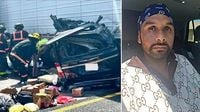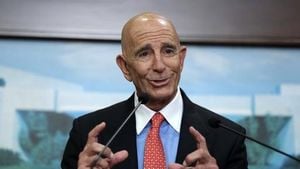The fatal crash that took three lives on Florida’s Turnpike in St. Lucie County has rapidly become a flashpoint in the national debate over immigration policy and state authority. At the center of the storm is Harjinder Singh, a 28-year-old Indian national who entered the United States illegally in 2018, later obtained a commercial driver’s license in California, and now faces three counts of vehicular homicide following the August 12, 2025 incident.
According to the Florida Highway Patrol, Singh was driving a commercial semi-truck when he attempted to make an illegal U-turn through an “Official Use Only” pass on the busy Florida Turnpike near Fort Pierce. The maneuver left his trailer blocking all northbound lanes, and a minivan slammed into the side of the trailer at full speed. The impact was devastating: a 37-year-old woman from Pompano Beach, a 30-year-old man from Florida City, and a 54-year-old man from Miami lost their lives. Two died at the scene, while the third succumbed to injuries at a local hospital. Singh and his passenger were uninjured, authorities confirmed.
The aftermath was immediate and intense. State Troopers, with assistance from Immigration and Customs Enforcement (ICE), issued a detainer for Singh under the 287(g) program, ensuring he would remain in custody and be subject to deportation proceedings after facing state charges. Singh is currently being held without bail in the San Joaquin County Jail and is scheduled to appear in court on August 19, 2025.
The incident quickly drew national attention—not only because of its tragic toll but also due to the circumstances surrounding Singh’s legal status and licensure. As reported by Fox News, Singh crossed the southern border into California in September 2018. He was apprehended by Border Patrol and processed for fast-track deportation by the Trump administration. However, Singh claimed he feared returning to India and, after being released on a $5,000 immigration bond in January 2019, entered ongoing asylum proceedings. He remained in the U.S. while awaiting a decision on his asylum claim.
Singh’s ability to work and drive commercially became a matter of fierce political contention. Tricia McLaughlin, Assistant Secretary at the Department of Homeland Security (DHS), clarified the timeline in response to public accusations and counter-accusations between the Trump and Biden administrations. “False. Harjinder Singh is in the United States illegally and his work authorization was rejected under the Trump Administration on September 14, 2020. It was later approved under the Biden Administration June 9, 2021,” McLaughlin stated, as reported by The New York Post. She further emphasized, “The state of California issues Commercial Drivers Licenses. There is no national CDL.”
After receiving his work permit in June 2021, Singh obtained a Commercial Driver’s License from California’s Department of Motor Vehicles. This, in turn, allowed him to be employed as a commercial truck driver—even as his immigration status remained unresolved. The revelation that a person in the country illegally could obtain such credentials, and subsequently be involved in a deadly crash, ignited a firestorm across the political spectrum.
Homeland Security Secretary Kristi Noem was among the first federal officials to respond publicly. In a post on X, she wrote, “Three innocent people were killed in Florida because Gavin Newsom’s California DMV issued an illegal alien a Commercial Driver’s License. This gut wrenching tragedy should have never happened. My team at DHS will work with USDOT to root out and prevent illegal aliens from obtaining these licenses from sanctuary jurisdictions that put American drivers and passengers in danger.”
The White House, echoing this sentiment, issued a statement: “The illegal alien is an Indian national who was granted a commercial driver’s license by the so-called ‘sanctuary state’ of California, whose reckless policies put the lives of American citizens at risk every single day.” The statement also criticized California Governor Gavin Newsom, saying, “But instead of acknowledging the tragedy, criminal illegal alien sympathizer Gavin Newsom callously doubled down, claiming that giving driver’s licenses to illegals ‘improves public safety.’”
Governor Newsom’s office, meanwhile, pushed back against the narrative, asserting that Singh entered the U.S. during the Trump administration and that, under California law, commercial driver’s licenses require lawful presence. Newsom’s team suggested that federal authorities had confirmed Singh’s eligibility at the time, a claim DHS officials disputed. The resulting back-and-forth between state and federal officials highlighted the complexities—and the finger-pointing—surrounding immigration enforcement and state-level licensing policies.
For the families of the victims, the political wrangling offers little solace. Dave Kerner, Executive Director of the Florida Highway Safety and Motor Vehicles (FLHSMV), spoke to the human cost: “The actions taken by the Defendant while operating a commercial tractor-trailer are both shocking and criminal. Three people lost their lives as a result of his recklessness, and countless friends and family members will experience the pain of their loss forever.” Kerner emphasized the state’s commitment to ensuring that individuals who pose a danger to others are brought to justice, adding, “He will no longer be able to damage and destroy the lives of Floridians and visitors. At the conclusion of his state charges, he will be deported.”
Amid the tragedy, the case has become a symbol for multiple, often conflicting, political agendas. For some, it’s a cautionary tale about the dangers of so-called “sanctuary” policies and the perceived breakdown of federal immigration enforcement. For others, it’s a reminder of the limits of state power and the complex pathways by which individuals navigate America’s immigration and legal systems. The debate has even drawn in former President Trump, who commented on WhiteHouse.gov, “The illegal alien is an Indian national who was granted a commercial driver’s license by the so-called ‘sanctuary state’ of California, whose reckless policies put the lives of American citizens at risk every single day.”
The details of the crash itself are stark and sobering. The semi-truck, towing a box trailer, attempted a U-turn in a section of the turnpike designated for “official use only.” As the truck crossed over all northbound travel lanes, the minivan collided with the trailer and became wedged beneath it. Emergency responders arrived quickly, but the damage had been done. Video footage from inside the truck cab, circulated on social media, showed Singh calmly putting the vehicle into park and shutting off the engine, seemingly unfazed by the chaos outside.
As Singh awaits his day in court, the ramifications of the crash continue to ripple outward. The case has reignited calls for stricter enforcement of immigration laws, more rigorous vetting for commercial driver’s licenses, and a reevaluation of state versus federal authority in matters of public safety. The victims’ families, meanwhile, are left to mourn—and the nation is left to grapple with the questions this tragedy has laid bare.
For now, Singh remains in custody, facing both state and federal consequences. The road ahead is likely to be marked by further legal battles, policy debates, and, for those directly affected, enduring grief.






